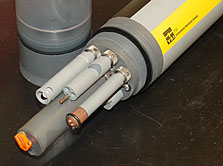2. How do we measure pH?
Measuring pH in salt water is more difficult than measuring pH in fresh water. The salt in seawater can interfere with the measurement. The pH paper tests are not suitable for measuring pH in salt water.
There are two methods commonly used to measure pH in an estuary. Colorimetric means to measure color. In the colorimetric method, chemicals are added to the water sample and those chemicals react with the water to produce a color change. The color indicates the pH of the water. The color can be measured visually or electronically. The colorimetric method does not work when the water is already colored because it contains dissolved organic matter or large amounts of algae. Colorimetric test kits are inexpensive and can cover a wide range of pH values.

pH electrode and meter (Click for larger image)
The second method uses a pH meter and pH probe. The pH probe is placed in the water sample and connected to the pH meter. At the tip of the probe there is a thin glass bulb. Inside the bulb are two electrodes that measure voltage. One electrode is contained in a liquid with a fixed pH. The other electrode responds to the pH of the water sample. The difference in voltage between the two probes is used to determine the pH. There are many pH meters designed for use in the field. The pH probe is used by research scientists and is how the pH of Narragansett Bay is measured on the RI/MA EMPACT Buoys. The cost of a pH meter and probe can be very expensive.
 |
Sensors used on the RI/MA EMPACT Buoys. If you were looking straight at the end on the instrument, the probe in the 9 o'clock position is a pH probe.
(Click for larger image) |
| 


